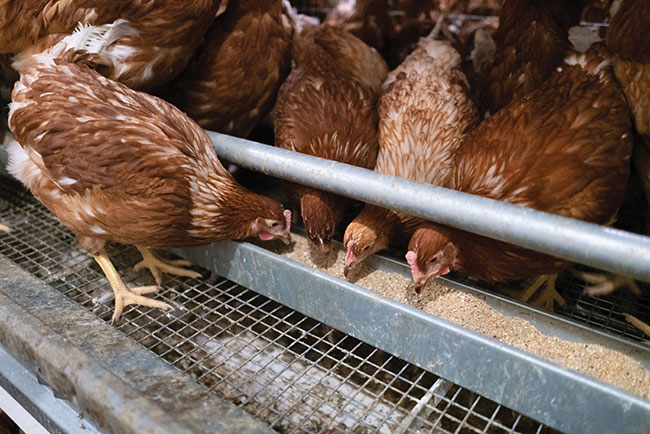
The path to 100-week layers
By Lisa McLean
Features Nutrition and FeedNew research seeks to maintain hen health through longer lay cycle.
 Scientists are examining how calcium and phosphorus travel through a hen’s body.
PHOTO CREDIT: Big Dutchman
Scientists are examining how calcium and phosphorus travel through a hen’s body.
PHOTO CREDIT: Big Dutchman For laying hens, strong bones and good eggshell quality both require phosphorus and calcium – two essential minerals that travel from the hen’s body to her eggs over time. As a result, at the end of a 70-week lay cycle, a hen’s supply of minerals in bone may be depleted leading to weaker bones.
Now, Marie-Pierre Létourneau-Montminy in Laval University’s Animal Science Department is leading an international multidisciplinary research team on two concurrent projects that aim to understand how calcium and phosphorus travel through a hen’s body at various stages of the life cycle, and how precision mineral feeding might help meet daily mineral requirements that would allow producers to extend a lay cycle.
“We are working to predict daily nutrition requirements of laying hens in calcium and phosphorus,” Létourneau-Montminy says. “We have a modelling project that, for the first time, collates all available published data to give us a better understanding of the fate of calcium and phosphorus in the gastrointestinal tract and then at metabolic level. And simultaneously, we are able to test the model’s predictions in a 100-week research trial.”
Limestone particle size matters
To simulate the fate of these minerals, the team first had to understand the extent of work that had already been done to track phosphorus and calcium in the digestive tract of a laying hen. The researchers faced an unexpected hurdle when they realized there was no information relating to the interaction between limestone particle size (a source of calcium) and phytase in laying hens, an enzyme that makes phosphorus from plants. Research partners in France performed a trial that provided information to address the gap.
“We confirmed large limestone particles interact less with phytase, and fine particle size will reduce the efficiency of the enzymes,” Létourneau-Montminy says. “Larger limestone particles stay in the gizzard longer, and since eggshells form at night when the hen eats less, they are an available source of calcium. This is particularly important as a hen ages and makes less efficient use of calcium.”
From there, the researchers were better able to predict phosphorus and calcium absorption.
In general, the hen has to take some calcium from the bone to deposit in the egg’s shell during the night, and that process delivers phosphorus, which is then lost in manure. With the modelling study data, the team was able to predict daily nutrition requirements throughout a hen’s life cycle – and even optimal time of day.
Measuring bone health
For the second part of the Létourneau-Montminy’s project, the researchers are putting the model predictions to the test by raising laying hens to 100 weeks with two different dietary phosphorus levels. The team is using a bone scanner tool commonly used in human medicine for osteoporosis diagnosis to test the hens’ bones for mineral content as well as body composition in fat and lean. Létourneau-Montminy hopes the project will give a better understanding of how bone evolves and the amount of calcium that transfers to eggs as hens age.
“With age, the birds enter osteoporosis, and they make less efficient use of calcium,” Létourneau-Montminy says. “We also tend to see a reduction of phosphorus.”
The importance of precision phosphorus
Létourneau-Montminy notes with world phosphorus reserves affected by rising prices and scarcity, producers face increasing pressure to be precise with this non-renewable resource. When the trial completes in November 2023, she hopes to have a better understanding of exactly how phosphorus and calcium are used in the hen’s body over time.
“We know that with aging, hens use more of their bone reserves, so we are looking at different strategies,” Létourneau-Montminy says. “With this trial, we will have important information about how mineral requirements change, and we will have many data points to help us fill in some of the knowledge gaps.”
Birds typically lay 350 eggs by the end of their 52-week cycle. By extending to 70 weeks of lay or 100 weeks of age, the aim is to get to 500 eggs, as long as the data supports the birds are in good physical shape. She notes the team is gathering information about bone composition, bone marrow density, mineral content in eggs and bones, as well as hormone levels in bloodwork over time.
Both the modelling project and the research trial will be completed by early 2023. Létourneau-Montminy hopes to complete a similar trial using the same design looking at vitamin D concentrations in diet and in layer hens.
This research is funded by the Canadian Poultry Research Council as part of the Poultry Science Cluster which is supported by Agriculture and Agri-Food Canada as part of the Canadian Agricultural Partnership, a federal-provincial-territorial initiative. Additional support was received from Egg Farmers of Canada, DSM and Avimix Nutrition.
Print this page